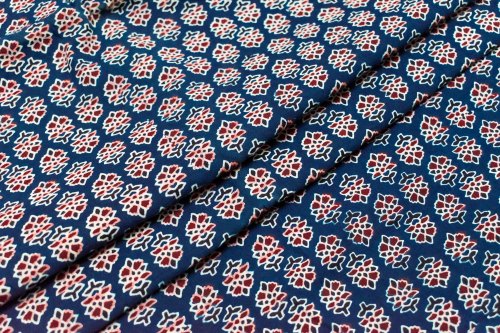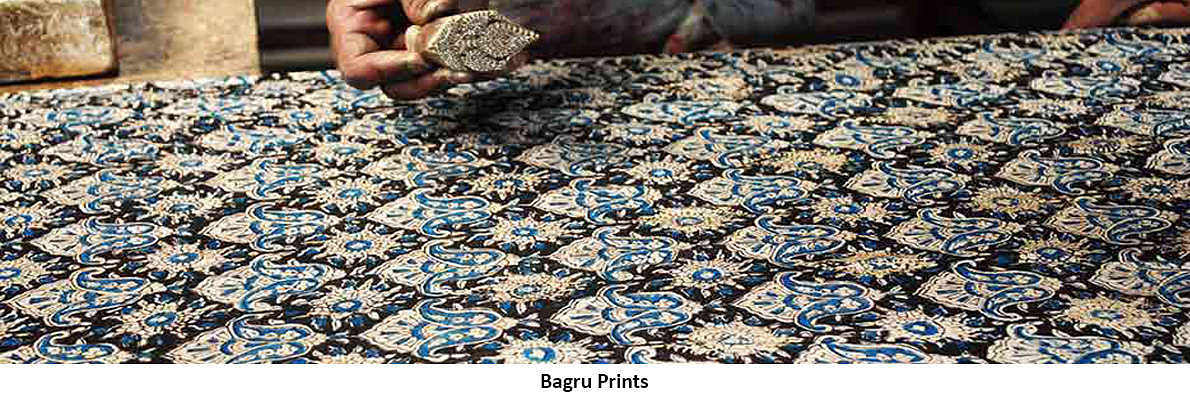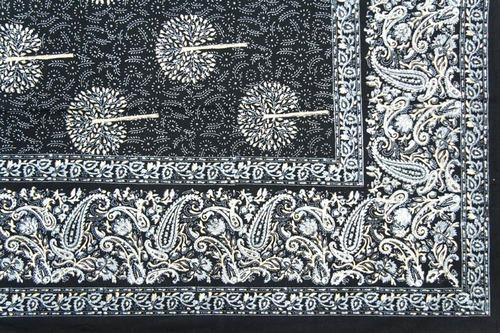
Ajrakh Print
Ajrakh was originated in Kutch, Gujrat and it is characterised by its unique dyeing technique called resist printing. The popular term ‘Ajrakh’ is derived from the persion Arabic term ‘Azarak’ which means blue.
The highly valued Ajrak has been made in Kutch for the Maldharis or cattle herders’ communities since the time Khatris migrated from Sindh in the 16th century. The Khatri community, whose name means “one who fills or changes colours,” printed cloth with the locally available natural dyes and water from the Dhamadka, the river that gave their village its name. Today the Ajrak traditions are maintained in Kutch, and in Khavda, Dhamadka and Barmer in Rajasthan. A large part of the credit of this art's revival goes to Dr. Ismail Mohamed Khatri, who has been acclaimed internationally as a master craftsman of the traditional Ajrakh, a craft that can be traced back up to ten generations in his family.
Ajrakh craft products are made with all-natural dyes which include both vegetable dyes and mineral dyes. Resist printing allows only the required portion of the fabric with art, leaving the remaining portion plain or uncoloured. Ajrakh printing is done mostly using colours like Indigo, iron, jaggery, spices, fruits, flowers and mud, and then Alum is used in the process to fasten the colours. Artisans also invent new colours by mixing them in a creative way.
Wooden block forms the most important part as it imparts geometry patterns making it unique. Wooden blocks are mainly used because they absorb natural colour better and uniformly. Blocks are mainly obtained from Acacia Arabica trees. The designs are very finely engraved by the experts. The design/ pattern is first drawn on the block using a grid system and then carved on it.
Process:
Saaj / Soaking:
The fabric is taken and washed to remove the starch and soaked into the solution of camel dung, soda ash, and castor oil. And kept overnight. The following day the cloth is dried in the open sun and soaked again in the same solution.
Kasano/ Fixing:
The solution of Myrobalan used as the mordant, nut from Harde tree is used to wash the cloth. The cloth is then dried from both sides in the sun. After drying excess myrobalan is brushed off the cloth.
Khariyanu/ Resist:
Lime (for whitewash) and gum arabic (Babool resin) is used as the resist and printed onto the cloth to outline the design/motifs that are required to be white. Rekh is the term used for this outline printing. It is printed on both sides of the cloth using carved wooden blocks.
Kat/ Black dye:
Here paste known as Kat is printed on both sides of the cloth. Scrap iron and jaggery mixed with water and kept for about 20 days. Further, they are mixed with tamarind seed powder and boiled to form a paste called Kat.
Gach/Combined Resist :
The paste of clay, alum, and gum arabic is used for the next resist printing in combination with the printing of lime and gum at the same time. This combined step is called Gach. Further sawdust or finely powdered cow dung is sprinkled on printed areas to prevent clay smudging. Thereafter, the cloth is kept for drying for about 5 days.
Indigo dyeing:
After dying with indigo, the cloth is dried in the sun and dyed again twice to ensure a uniform coating.
Vichcharnu:
Here, the cloth is thoroughly washed to remove the unfixed dye and all the resistive print
Rang:
Finally, the cloth is boiled with Alizarin a synthetic madder, imparting bright red colour to the portions of alum residues where alum fixes the red colour. The grey areas from the black printing get a deep shade. To obtain different colours cloth is dyed with different materials. For instance, for orange colour natural madder root is used, yellowish-green colour is obtained using Henna, while brownish colour is achieved using rhubarb roots.
Interesting Facts:
- Artifacts related to Ajrakh have been found in the excavated remains from the Indus valley civilizations- Harappa and Mohenjo-Daro. Cloth artifacts with similar dyeing techniques have also been found in the Al-Fustat excavations in the Nile delta near Cairo, Egypt.
- Ajrakh is said to signify the Universe. Because of the use of colour palate. Colour red for earth, black for darkness, white for clouds and blue for Universe itself. Think moonless, think midnight, and think darkness… the star-spangled sky, against a stark blue-black background. This is what Ajrakh , meaning blue in Arabic, is likened to.
- Historically, Ajrakh has been printed on both sides. This is because the cattle herders, who used to wear Ajrakh traditionally, would leave their homes even before sun rise and there was no electricity in those times so they couldn’t differentiate the right side from the wrong side in darkness. Double-side printing ensured that they could wear it either way.
- Ajrakh is colourful and bright for a reason. It was not just cattle that could get lost in the white desert. It was not uncommon for cattle herders to lose their sense of direction in the endless sands of desert. Bright colours made it easier for others to locate them even at a distance.
- Ajrakh when printed single-sided is called "Ekpuri" and double-sided Bipuri".
You can now shop for beautiful block printed Ajrakh dresses, night wear, casual and formal wear at UNBLOCK By Jenny- Your ONE STOP SHOP for unique designs with a touch of tradition.


